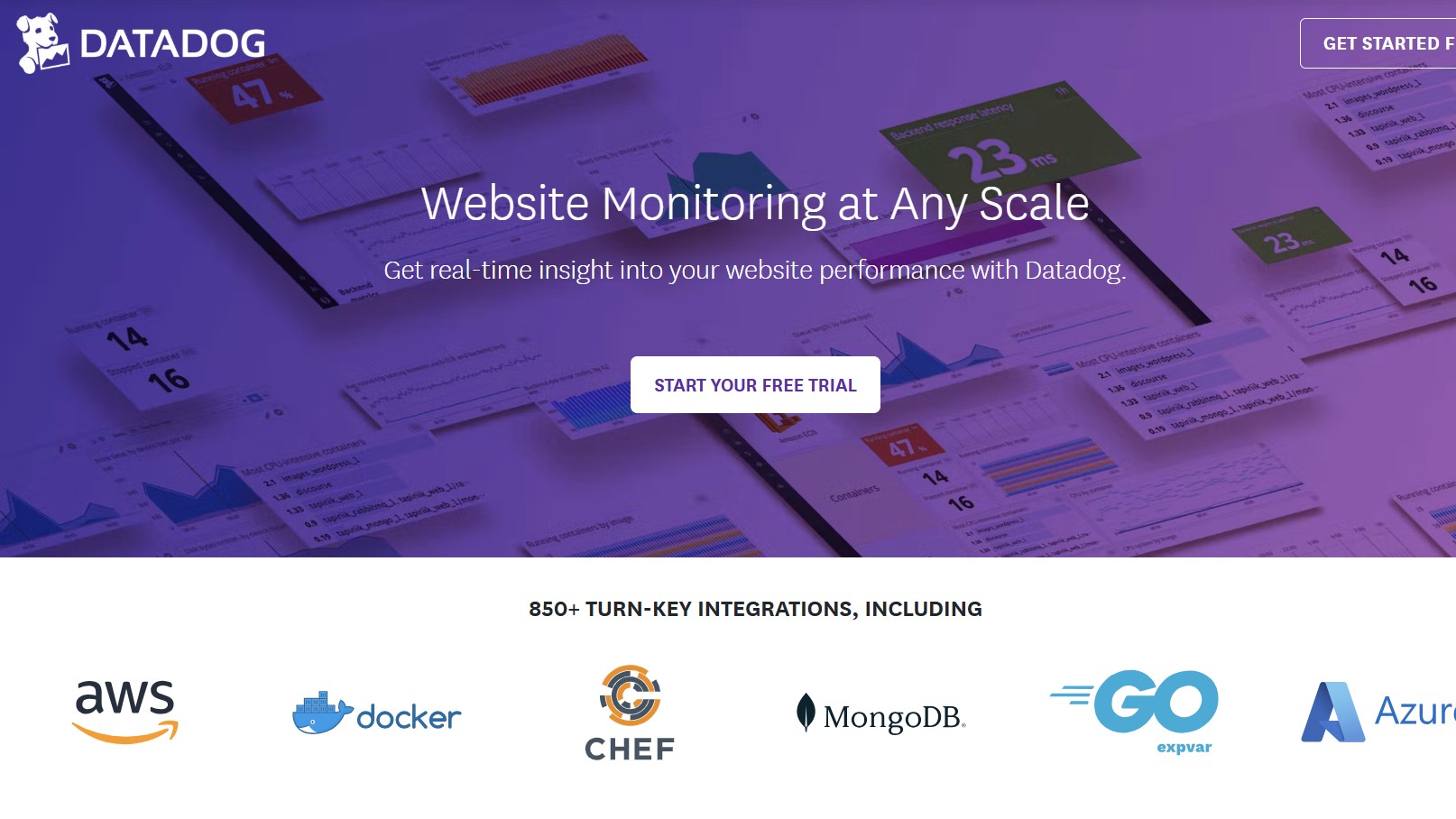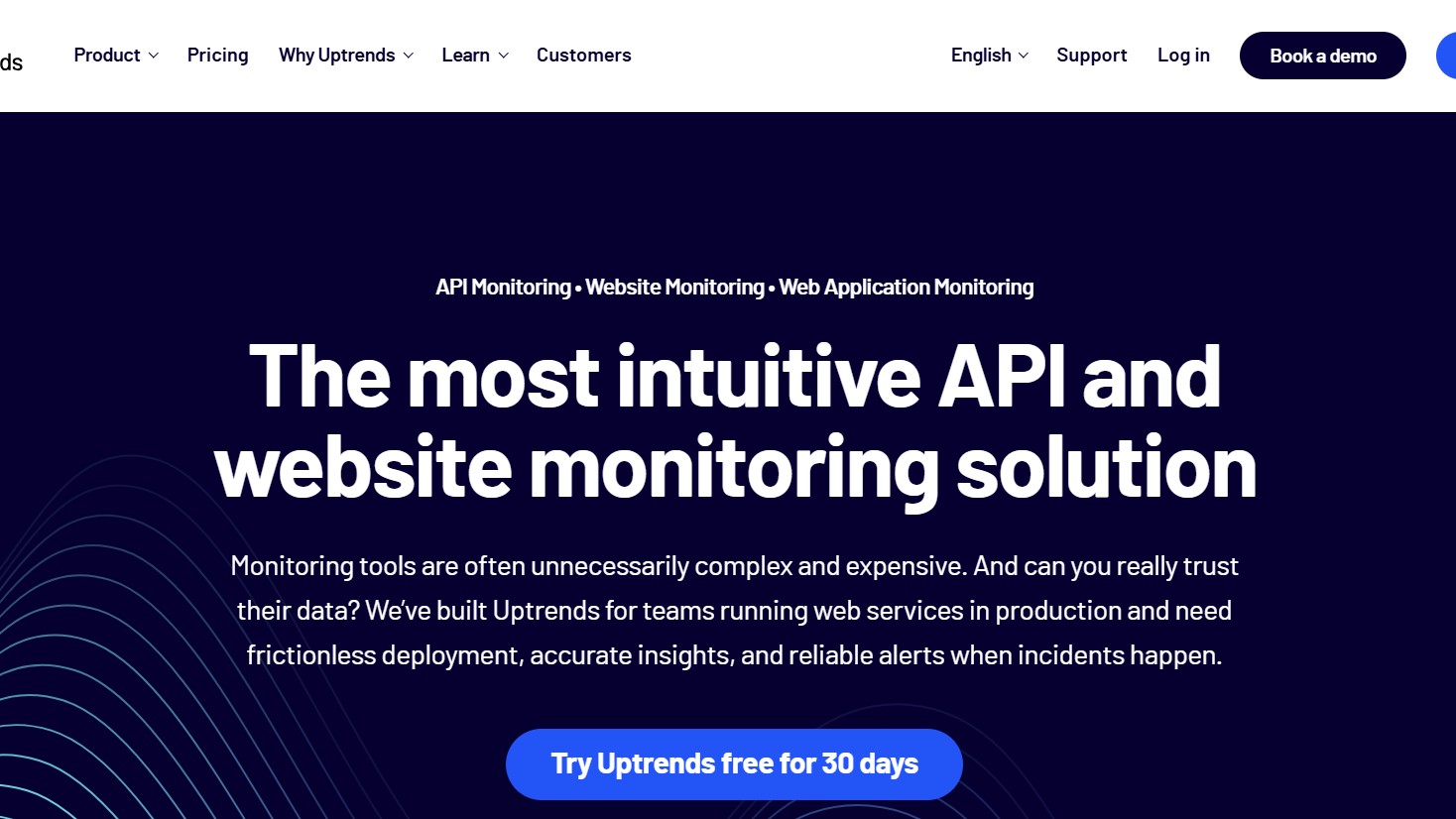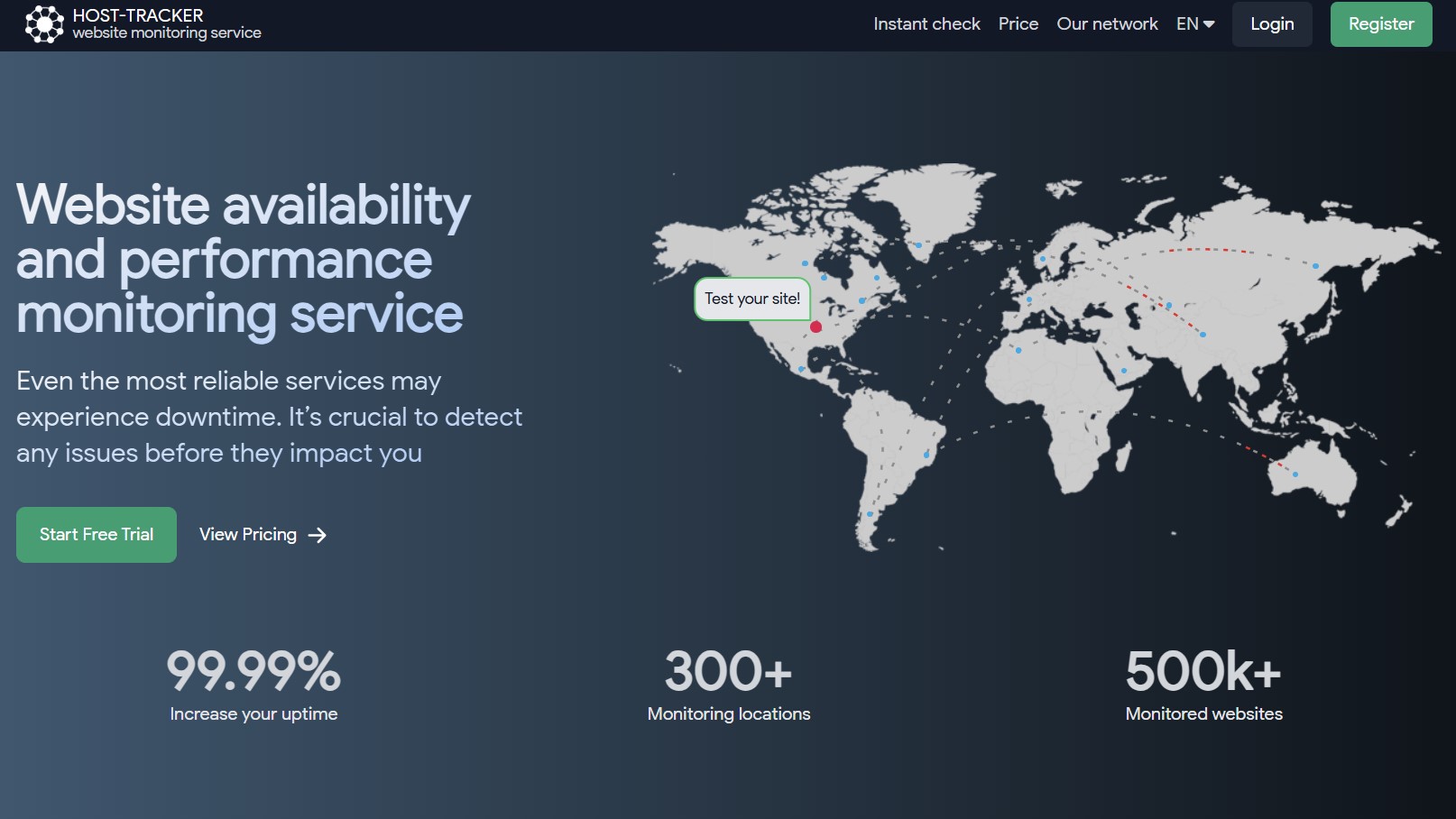Best website monitoring software of 2025
Keep track of your website performace

A business today is only as good as its website. Even with the best web hosting services, downtimes can occur due to various reasons, such as technical glitches, cyberattacks, or human error. This is where the best website monitoring software is crucial.
Regardless of the cause, business owners must be the first ones to know about an outage. Besides losing out on revenue, website downtimes lead to loss of reputation. More than 9% of visitors do not return to a website if they find it is not working. Is that a risk you’re willing to take?
A website monitor keeps an eye on the availability of your web pages and sends you instant alerts if a downtime happens. You can also use Real User Monitoring to improve your SEO rankings as per customer feedback and experience and synthetic monitoring to test out various technical parts of your page.
However, with so many options around, finding the right monitoring software can be quite a task. To help you out, we’ve tested, reviewed, and compiled the best website monitoring solutions on the market right now.
The best website monitoring software of 2025 in full:
Why you can trust TechRadar
Best website monitoring software overall
Reasons to buy
Reasons to avoid
Uptime is one of the best website monitoring tools thanks to the sheer number of features it offers. For starters, there are more than 20 types of basic checks, including Ping, IMAP, Whois/Domain, TCP Port, and SSL/Certificate, available right from the starter plan.
A lot of times, websites use APIs to integrate with other services, say payment pages. Advanced Uptime.com check options include API monitoring that lets you test various API integrations such as REST APIs, gRPC APIs, and GraphQL APIs.
Uptime also offers a very easy-to-use no-code transaction check that lets you monitor specific parts of your webpage. For instance, if yours is an e-commerce website, you might want to ensure that users are able to add products to the cart.
You can specifically test out this transaction without any coding. Simply load the page on Uptime and mimic the user journey you want to test. Once done, set up a monitor for the transaction, and you’re done.
If these synthetic monitoring tools aren’t enough, you can switch to Uptime’s Real User Monitoring (RUM), which can scour through as many as 1.5M page views to fetch real user behavior data. This gives you detailed insights into user trends.
We liked the escalation hierarchy option offered by Uptime. Every time there’s an incident, you can choose which team member gets the notification. If the issue remains unsolved for a specific period (say, 2 hours), Uptime will automatically send escalation alerts to the next higher authority and so on. This ensures that each outage is dealt with with immediate attention.
If there’s an outage, you can use Uptime’s customizable status pages to keep visitors informed about the incident. Plus, Uptime is one of the few website monitoring platforms offering private status pages for internal communication needs.
That said, all these features come at a cost. The basic paid plan starts at $20/month and can go all the way up to $285/month.
Read our full Uptime.com review.
Best website monitoring software for real user monitoring
Reasons to buy
Reasons to avoid
We found Datadog really ideal for Real User Monitoring (RUM) thanks to its detailed session replays. You can watch video-like replays of actual user sessions and activities like clicks, scrolls, keystrokes, and so on. This helps a business understand the root cause of low engagement and conversion rates and improve UX/UI issues.
The platform also pulls out Core Web Vitals during these sessions, which allows website owners to understand SEO factors like loading performance, inactivity, and visual stability. Search engines like Google use these Core Web Vitals for ranking content. So, the more ideal your website’s scores are, the better your online visibility becomes.
Much like Uptime, Datadog also offers API monitoring and transaction checks. You can access Datadog’s API Catalog to check your overall HTTP test coverage. If you find any untested endpoints, you can build a new API check in just a few clicks.
Besides this, Datadog has one of the largest collections of third-party integrations. You can connect to as many as 800+ apps to build a seamless workflow. The platform’s pricing is also rather unique. It offers function-wise plans instead of pre-defined bundles like others.
So, for instance, if you only want RUM functions, you’ll have to shell out only $1.80/month for 1,000 sessions. Similarly, API testing costs $5/month for 10K runs, and browser testing costs $12/month per thousand runs. This makes it an affordable option for small and mid-sized businesses.
Read our full Datadog review.
Best affordable website monitoring software
Reasons to buy
Reasons to avoid
If you’re looking for an affordable website monitor, UptimeRobot is a good option. Plans start from just $7/month and offer robust synthetic monitoring functions. You can run 8 different types of monitors, including HTTP, port & ping monitoring, with a check interval as low as 30 seconds.
UptimeRobot does a good job at cron job monitoring, which allows you to automate pre-scheduled tasks at regular intervals. For instance, you can run cron jobs to check disk usage, ensure automated backups, or monitor log files.
You can also set up SSL and domain expiry alerts, and the platform will send you notification 30, 14, 7, and 1 day before the scheduled expiry.
Sometimes, your website may undergo scheduled maintenance. Running a monitor at that time may result in a lot of false positives and dent your uptime numbers. With UptimeRobot, however, you can set up a custom maintenance window to pause all monitoring activities.
What we also like about UptimeRobot is that it doubles up as a content monitoring platform thanks to keyword alerts. You can set up a monitor on your competitors' websites with specific keywords like ‘sale’ so that you do not miss out on any trends. This way, you won’t separately have to invest in a dedicated content monitor.
Read our full UptimeRobot review.
Best website monitoring software for large businesses
Reasons to buy
Reasons to avoid
If you’re a large business looking for higher-threshold monitoring plans, Pingdom can be an excellent choice. It only offers two plans – one for synthetic monitoring and one for RUM. However, it is the sheer number of options you get in each plan that makes it a go-to choice for businesses. Under each plan, you get 22 options, each with a different number of monitors and alerts.
For instance, the synthetic monitoring plan starts at $10/month and comes with 10 uptime monitors, 1 advanced monitor (page speed or transaction checks), and 50 SMS alerts. This can go all the way up to 30,000 uptime monitors, 2,500 advanced monitors, and 1,500 SMS alerts with the $18,300/month plan.
Even on the RUM plan, you can choose up to 1 billion pageviews for $15,000/month. There are only a few website monitors that can support such huge requirements.
We like Pingdom’s page speed tests, which aren’t just limited to checking the load times. It performs an in-depth analysis into how various page elements such as CSS, HTML, and JavaScript are performing in relation to each other.
This helps you zero in on the element that has been slowing your website. Pingdom doesn’t stop there – it goes a step ahead and assigns grades to each test. This way, you don’t have to go through all the tests, and you’ll know at just a glance if there’s an issue.
If Pingdom flags any outages, it runs a detailed root cause analysis and allows admins to run traceroute to find the exact cause of disruption.
Read our full Pingdom review.
Best website monitoring software for free tracking tools
Reasons to buy
Reasons to avoid
If you cannot shell out money for monitoring right now, you can use Site24x7’s 100 free tools to check various aspects of your website. For example, you can use the website availability tool to check if your website is live from various locations.
Similarly, you can ping your website to check if it's working. You’ll also find a tool to monitor your SSL certificate. Besides this, you also get an SLA uptime calculator and a host of content and formatter tools. This can come in handy for small businesses and startups that aren’t ready yet to invest in a full-fledged monitoring tool.
We also found Site24x7’s paid plans pretty comprehensive, offering good value for money. For instance, its $35/month Pro plan offers 40 basic monitors with a check frequency of 1 minute, 3 advanced monitors, and 500k RUM pageviews. Add to this 3 basic status pages along with several third-party integrations, and you’ll have a complete website monitoring solution.
Site24x7 is also known for its defacement monitoring that uses a baseline document object model (DOM) mechanism during checks. Current DOMs are compared with previous ones to identify any unauthorized hacks or changes.
Just like Uptime, you can use a no-code recorder to set up and run various transaction checks and use JSONPath or XPath assertions to monitor API integrations. However, unlike other monitoring platforms, Site24x7 also offers network monitoring on all its plans.
Read our full Site24x7 review
Other website monitoring software to consider
Although the five website monitoring tools mentioned above are, quite frankly, the best in business, here are some other honorable mentions that are just as good.
Monitoring software with feature-wise payment model
Reasons to buy
Reasons to avoid
Uptrends is a good value-for-money website monitor, offering feature-wise plans. For instance, synthetic transaction monitoring costs $8.17/month, while real user monitoring costs $8.91/month. If you only want to check the uptime and availability of your webpage, you’ll have to pay $5.10/month.
This approach makes it an affordable option for small businesses that do not need extensive monitoring functions. Another good thing about Uptrends is that it lets you monitor your pages from as many as 233 global checkpoints.
This is the largest pool of servers offered by a website monitor. Its dashboards are also very information-oriented and filled with a lot of charts and graphs, making it easy to spot any errors.
Read our full Uptrends review.
Top-notch monitoring software offering great value for money
Reasons to buy
Reasons to avoid
HostTracker is another good website monitoring solution, starting at just $9.9/month for 10 website checks at an interval of 5 minutes. Adding additional websites to the plan costs just $0.70/site.
Unlike other monitors, HostTracker does a good job when it comes to database monitoring. It checks your MySQL, PostgreSQL, and Microsoft SQL Servers for any speed and connection stability and ensures they remain available when you need them. Plus, you also get synthetic transaction monitoring and custom API checks.
Besides this, HostTracker scours the DNSBL databases and Google's unsafe websites list to check if any of your websites have been blacklisted. If so, it will help you resolve the issue as soon as possible. That said, HostTracker lacks real user monitoring functions and status pages, which can be a deal breaker for some users.
Read our full HostTracker review.
We've also listed the best website defacement monitoring service.
Best website monitoring software FAQs
What is website monitoring?
Website monitoring is a comprehensive process of tracking various aspects of a website, such as uptime, performance, and security. It's, in fact, a wide term encompassing a lot of functions. For example, there are various availability monitoring solutions that keep an eye on your website’s uptime and send alerts if they find any outages.
Similarly, there are solutions that allow you to better understand your users with real user monitoring. On the flip side, certain providers facilitate synthetic website testing to ensure all website elements are working as they should. Website monitoring is also used to traceroute website errors and helps in incident resolution.
What is the difference between website monitoring and content monitoring?
Website monitoring solutions focus on measuring aspects like a website’s availability, performance, and security infrastructure to ensure that a website is visible and performing well. Some popular website monitors are Uptime, Datadog, and UptimeRobot.
Content monitoring, on the other hand, focuses only on the content of a website and sends you alerts when it notices a content change. This can come in handy for purposes like competitor monitoring, SEO monitoring, and ensuring regulatory compliance. Some popular content monitors are Visualping, PageCrawl, and Distill.io.
Which is the best website monitoring tool?
Uptime is one of the best website monitoring tools, offering a bunch of features in a single place. Besides more than 20 types of basic checks, you get advanced monitoring options such as API checks, no-code transaction checks, and Real User Monitoring.
You can run these checks from various global locations at a frequency of as low as 1 minute (on the higher-end plan). Plus, you can customize your own status pages to keep your visitors informed during an outage. There are also private status pages for internal communications.
How to choose the best website monitoring tool?
There are quite a few things to consider while picking a website monitoring solution. Let’s look at them one by one.
Firstly, define what you exactly need from a website monitor. Do you only want to view uptime and availability or want to dig deeper with real user monitoring and run tests with synthetic monitoring?
Once your expectations are clear, you need to underline the features you’re looking for. Some common functions include real-time downtime alerts, monitoring from multiple locations, detailed reporting dashboards and analytical data, and integration with pre-existing business tools.
If you have a business that's growing, you should also consider the scalability of the platform. The monitor should be able to accommodate your growing needs and not require you to make a provider switch.
Lastly, set a realistic budget depending on your purpose and feature needs. Then, find a solution that offers the best match between your budget and features, i.e., look for a solution offering most of the features you need within your budget.
What is the difference between synthetic website monitoring and real user monitoring?
Synthetic website monitoring takes place in a controlled environment where real user interaction paths are stimulated to check various aspects, such as page load speeds, clicks, or form submissions. This can help businesses identify key bottlenecks in their website design and APIs, which have been leading to lower customer clicks and interaction.
Real user monitoring, on the other hand, uses data from real users to harness data like page load speeds, heatmaps, and customer interactions. This helps you to identify pain points based on real user data. You can then use synthetic monitoring to test and improve on those parts.
How we tested the best website monitoring software
To test the best website monitoring software, we first sign up and make an account so that we can access all of its features. Then, we run various tests such as page speed tests, uptime tests, and synthetic tests, such as API monitoring and RUM tests.
We evaluate how many websites the software checks, whether the alerting policies can be customized, and if the software offers testing from servers across the world. Apart from this, we set up regular monitors on various websites and take them down for a few minutes to check if the website monitor is able to detect and alert us of the downtime.
What's more, we also test several third-party integrations to check if we’re able to build seamless workflows. Lastly, we reach out to their customer support team with both basic and tricky queries. This helps us understand the promptness and accuracy of a provider’s support wing.
Read more on how we test, rate, and review products on TechRadar.
Get in touch
- Want to find out about commercial or marketing opportunities? Click here
- Out of date info, errors, complaints or broken links? Give us a nudge
- Got a suggestion for a product or service provider? Message us directly
- You've reached the end of the page. Jump back up to the top ^
Sign up to the TechRadar Pro newsletter to get all the top news, opinion, features and guidance your business needs to succeed!
Krishi covers buying guides and how-to's related to software, online tools, and tech products here at TechRadar. Over at Tom's Guide, he writes exclusively on VPN services. You can also find his work on Techopedia and The Tech Report. As a tech fanatic, Krishi also loves writing about the latest happenings in the world of cybersecurity, AI, and software.






